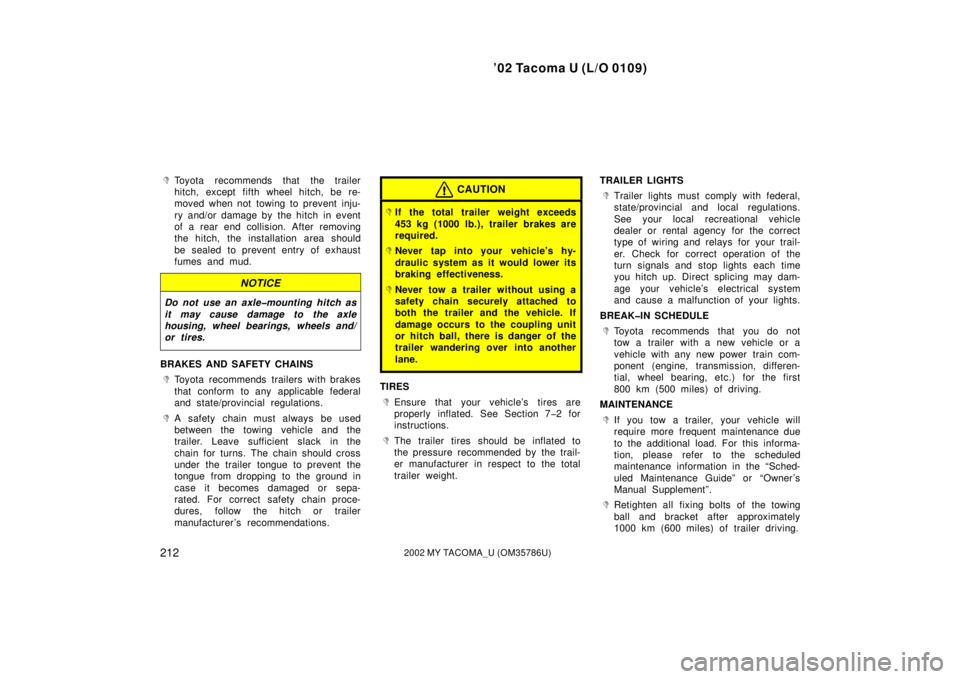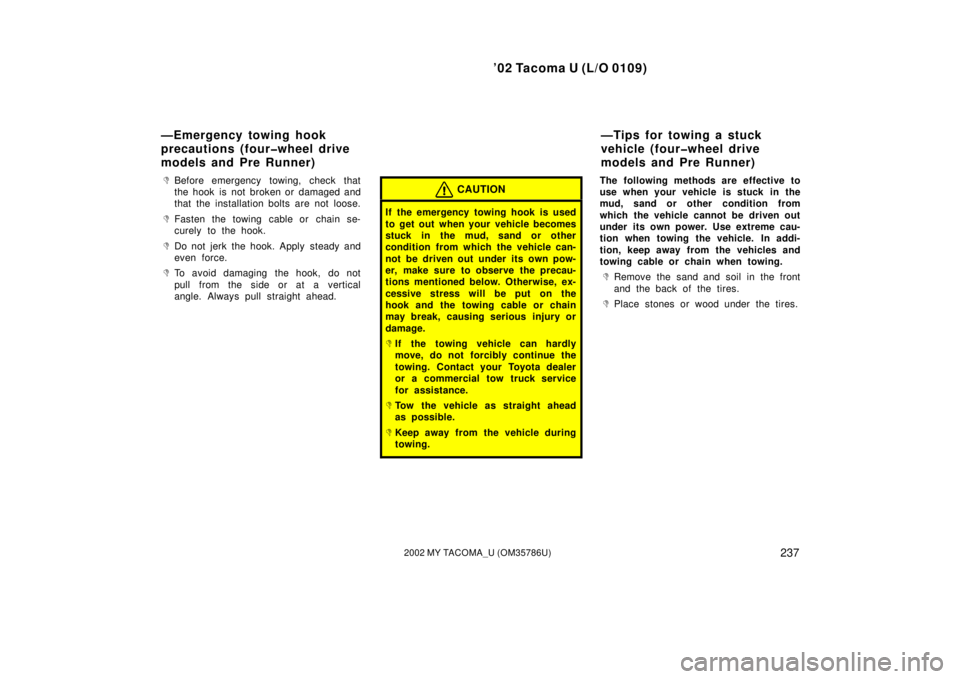Page 218 of 308

’02 Tacoma U (L/O 0109)
2122002 MY TACOMA_U (OM35786U)
�Toyota recommends that the trailer
hitch, except fifth wheel hitch, be re-
moved when not towing to prevent inju-
ry and/or damage by the hitch in event
of a rear end collision. After removing
the hitch, the installation area should
be sealed to prevent entry of exhaust
fumes and mud.
NOTICE
Do not use an axle�mounting hitch as
it may cause damage to the axle
housing, wheel bearings, wheels and/
or tires.
BRAKES AND SAFETY CHAINS
�Toyota recommends trailers with brakes
that conform to any applicable federal
and state/provincial regulations.
�A safety chain must always be used
between the towing vehicle and the
trailer. Leave sufficient slack in the
chain for turns. The chain should cross
under the trailer tongue to prevent the
tongue from dropping to the ground in
case it becomes damaged or sepa-
rated. For correct safety chain proce-
dures, follow the hitch or trailer
manufacturer ’s recommendations.
CAUTION
�If the total trailer weight exceeds
453 kg (1000 lb.), trailer brakes are
required.
�Never tap into your vehicle’s hy-
draulic system as it would lower its
braking effectiveness.
�Never tow a trailer without using a
safety chain securely attached to
both the trailer and the vehicle. If
damage occurs to the coupling unit
or hitch ball, there is danger of the
trailer wandering over into another
lane.
TIRES
�Ensure that your vehicle’s tires are
properly inflated. See Section 7�2 for
instructions.
�The trailer tires should be inflated to
the pressure recommended by the trail-
er manufacturer in respect to the total
trailer weight.TRAILER LIGHTS
�Trailer lights must comply with federal,
state/provincial and local regulations.
See your local recreational vehicle
dealer or rental agency for the correct
type of wiring and relays for your trail-
er. Check for correct operation of the
turn signals and stop lights each time
you hitch up. Direct splicing may dam-
age your vehicle’s electrical system
and cause a malfunction of your lights.
BREAK�IN SCHEDULE
�Toyota recommends that you do not
tow a trailer with a new vehicle or a
vehicle with any new power train com-
ponent (engine, transmission, differen-
tial, wheel bearing, etc.) for the first
800 km (500 miles) of driving.
MAINTENANCE
�If you tow a trailer, your vehicle will
require more frequent maintenance due
to the additional load. For this informa-
tion, please refer to the scheduled
maintenance information in the “Sched-
uled Maintenance Guide” or “Owner ’s
Manual Supplement”.
�Retighten all fixing bolts of the towing
ball and bracket after approximately
1000 km (600 miles) of trailer driving.
Page 236 of 308
’02 Tacoma U (L/O 0109)
2302002 MY TACOMA_U (OM35786U)
7. Remove the wheel nuts and changetires.
Lift the flat tire straight off and put it
aside.
Roll the spare wheel into position and
align the holes in the wheel with the bolts.
Then lift up the wheel and get at least the
top bolt started through its hole. Wiggle
the tire and press it back over the other
bolts.
Before putting on wheels, remove any cor-
rosion on the mounting surfaces with a
wire brush or such. Installation of wheels
without good metal�to�metal contact at the
mounting surface can cause wheel nuts to
loosen and eventually cause a wheel to
come off while driving. Therefore after the
first 1600 km (1000 miles), check to see
that the wheel nuts are tight.8. Reinstall all the wheel nuts finger tight.
Reinstall the wheel nuts (tapered end in-
ward) and tighten them as much as you
can by hand. Press back on the tire back
and see if you can tighten them more.
—Changing wheels —Reinstalling wheel nuts
Page 243 of 308

’02 Tacoma U (L/O 0109)
2372002 MY TACOMA_U (OM35786U)
�Before emergency towing, check that
the hook is not broken or damaged and
that the installation bolts are not loose.
�Fasten the towing cable or chain se-
curely to the hook.
�Do not jerk the hook. Apply steady and
even force.
�To avoid damaging the hook, do not
pull from the side or at a vertical
angle. Always pull straight ahead.
CAUTION
If the emergency towing hook is used
to get out when your vehicle becomes
stuck in the mud, sand or other
condition from which the vehicle can-
not be driven out under its own pow-
er, make sure to observe the precau-
tions mentioned below. Otherwise, ex-
cessive stress will be put on the
hook and the towing cable or chain
may break, causing serious injury or
damage.
�If the towing vehicle can hardly
move, do not forcibly continue the
towing. Contact your Toyota dealer
or a commercial tow truck service
for assistance.
�Tow the vehicle as straight ahead
as possible.
�Keep away from the vehicle during
towing.
The following methods are effective to
use when your vehicle is stuck in the
mud, sand or other condition from
which the vehicle cannot be driven out
under its own power. Use extreme cau-
tion when towing the vehicle. In addi-
tion, keep away from the vehicles and
towing cable or chain when towing.
�Remove the sand and soil in the front
and the back of the tires.
�Place stones or wood under the tires.
—Emergency towing hook
precautions (four�wheel drive
models and Pre Runner)— Tip s fo r to win g a st u ck
vehicle (four�wheel drive
models and Pre Runner)